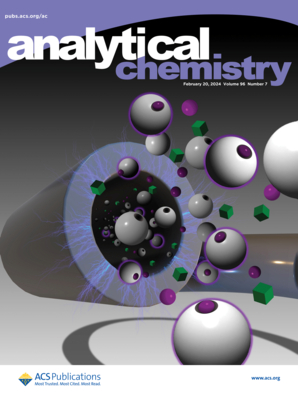p-Cresol and C. difficile: A Love-Hate Story Revealed by Raman Spectroscopy.
IF 6.7
1区 化学
Q1 CHEMISTRY, ANALYTICAL
引用次数: 0
Abstract
Clostridioides difficile is known to produce p-cresol, a phenolic compound with selective antimicrobial properties, which may contribute to its competitive advantage within the gut microbiome. In this study, we investigated the interaction between Clostrioides difficile and Escherichia coli in coculture to assess the role of p-cresol in modulating interspecies dynamics. Raman spectroscopy was employed as a label-free, nondestructive analytical technique to profile the molecular signatures of both species in mono- and coculture. Excitation wavelengths at 244 and 532 nm were used to enhance complementary vibrational features, including those associated with aromatic compounds like p-cresol. Our results demonstrate distinct spectral changes in coculture conditions suggesting the involvement of p-cresol and its impact on the biochemical composition of E. coli. This dual-wavelength Raman approach offers a powerful means of characterizing microbial interactions and identifying metabolic markers that may drive microbial competition and survival.对甲酚和艰难梭菌:拉曼光谱揭示的爱恨交织的故事。
艰难梭菌已知产生对甲酚,一种具有选择性抗菌特性的酚类化合物,这可能有助于其在肠道微生物群中的竞争优势。在这项研究中,我们研究了艰难梭状芽孢杆菌和大肠杆菌在共培养中的相互作用,以评估对甲酚在调节种间动力学中的作用。拉曼光谱是一种无标记、无损的分析技术,用于分析单培养和共培养中两种植物的分子特征。244和532 nm的激发波长用于增强互补振动特征,包括与对甲酚等芳香族化合物相关的振动特征。我们的研究结果表明,共培养条件下明显的光谱变化表明对甲酚的参与及其对大肠杆菌生化组成的影响。这种双波长拉曼方法提供了表征微生物相互作用和识别可能驱动微生物竞争和生存的代谢标记的有力手段。
本文章由计算机程序翻译,如有差异,请以英文原文为准。
求助全文
约1分钟内获得全文
求助全文
来源期刊

Analytical Chemistry
化学-分析化学
CiteScore
12.10
自引率
12.20%
发文量
1949
审稿时长
1.4 months
期刊介绍:
Analytical Chemistry, a peer-reviewed research journal, focuses on disseminating new and original knowledge across all branches of analytical chemistry. Fundamental articles may explore general principles of chemical measurement science and need not directly address existing or potential analytical methodology. They can be entirely theoretical or report experimental results. Contributions may cover various phases of analytical operations, including sampling, bioanalysis, electrochemistry, mass spectrometry, microscale and nanoscale systems, environmental analysis, separations, spectroscopy, chemical reactions and selectivity, instrumentation, imaging, surface analysis, and data processing. Papers discussing known analytical methods should present a significant, original application of the method, a notable improvement, or results on an important analyte.
 求助内容:
求助内容: 应助结果提醒方式:
应助结果提醒方式:


